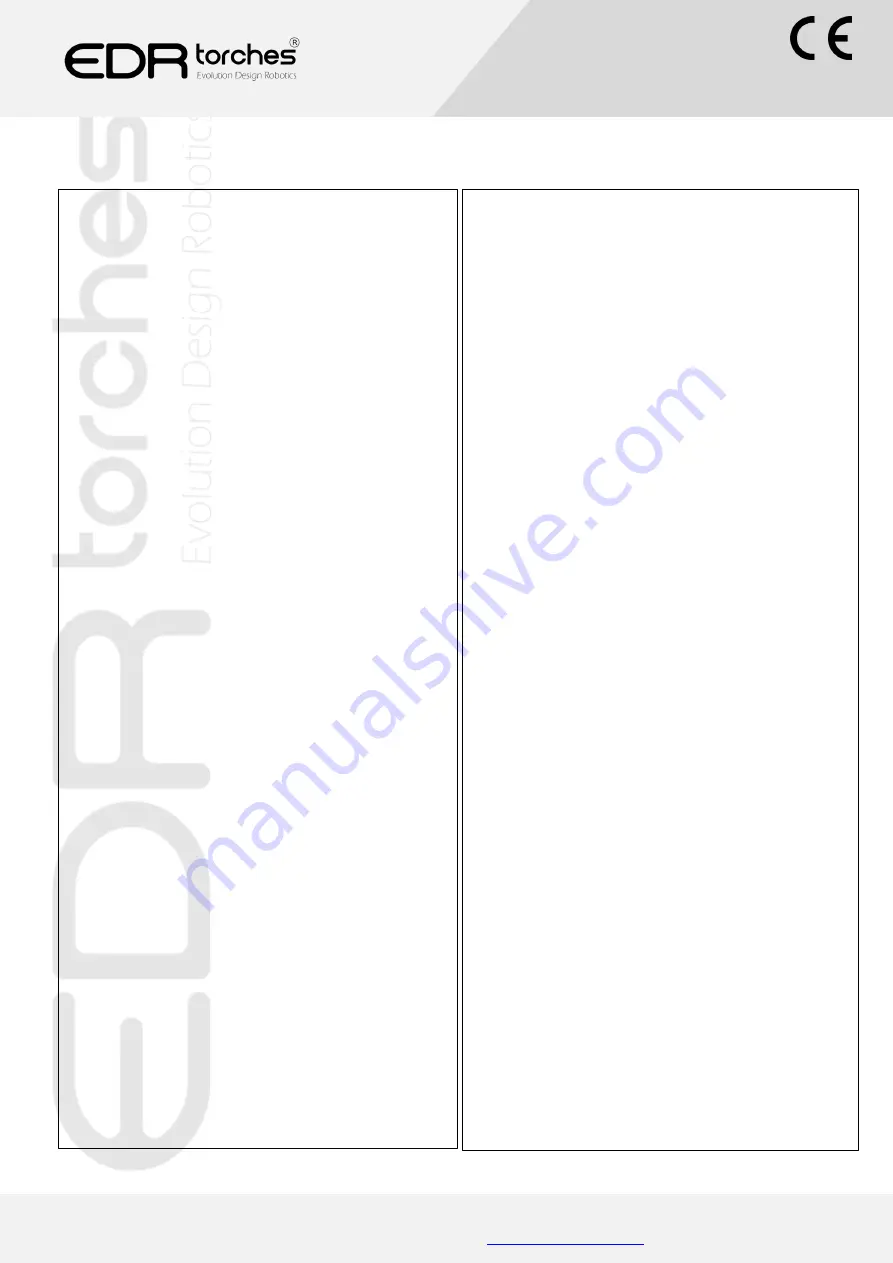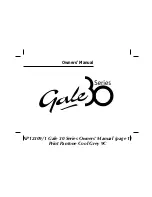
14
INSTRUCTION MANUAL
MANUAL DE INSTRUCIONES
MANUEL D´INSTRUCTIONS
IEC 60974-7
MT-TS-081218
EDRtorches S.L. - [email protected]
- 0034 963 558 893
INTRODUCTION.
It is advisable that the connection and later handling of the torches
be carried out by people familiar with the process, as far as possible.
Compliance with the following instructions will prevent possible
accidents or poisoning.
PREVENTION AGAINST ELECTRICAL SHOCK.
Periodically check the welding equipment to check its proper
functioning. In installation or maintenance operations it is necessary
to ensure the electrical disconnection of the machine or power
supply. Avoid human contact simultaneously of the mass or base
material with the contact tip or supply thread. Avoid contact with
parts directly subjected to electrical power. Do not weld in
environments with an excessive degree of humidity. Avoid any
contact of the torch with water and wet or damp surfaces. Do not
weld wet or damp parts. Secure all electrical connections.
SAFETY AGAINST GASES AND WELDING FUMES.
The materials used in welding can sometimes give off gases and
vapors harmful to health, to avoid them we will observe the following:
Carry out the welding process in ventilated places or, failing that,
provide bells or extractors. Do not weld around flammable gases,
fuels or chlorine vapors. Do not ventilate or dry with pure oxygen.
PROTECTION AGAINST BURNS AND RADIATIONS
To avoid burns by projections and ultraviolet radiation, use the
appropriate equipment, which should include: gloves, footwear,
protective clothing as well as helmet with appropriate filter lenses.
Isolate the welding place with panels or curtains. Failing that, protect
the surrounding personnel with the appropriate equipment.
PREVENTIONS AGAINST FIRE AND EXPLOSIONS
Avoid the proximity of gases and flammable substances that may
cause explosions or fires as a result of the incandescent projections
that occur during welding. Do not weld containers that contain or
have contained flammable materials without first cleaning them
properly. Never use pure oxygen for the drying or sweeping of any
substance.
STORAGE AND HANDLING OF GASES.
Isolate and protect circuit bottles or electric cables. Close the valves
when we stop the welding process. Use exclusively certified tubes and
fittings according to the characteristics of the gas. Protect bottles
from possible bumps and falls.
Use the right pressure regulator and ensure its proper functioning.
OTHER PRECAUTIONARY MEASURES.
Avoid any pressure on the cables. Do not hit the torches when
carrying out maintenance, repair or installation operations.
Do not bend excessively the cables to avoid possible strangulation of
the elements. Avoid drafts over the welding area. Do not change the
spare or handle the gun while hot.
MAINTENANCE NORMS.
To guarantee the correct functioning of the torches, the use of
original spare parts is recommended. Before starting any repair or
maintenance operation, disconnect the welding machine and allow
the torch to cool down. Change the contact tips when they show
any expansion or deformation in the hole. Periodically clean
projections inside the nozzle, diffuser holes and contact tip. Apply
spray or non-stick paste to these same parts without excess that can
obstruct the passage of gas. Check and change if damaged parts
are coming periodically. In water-cooled torches, check that the
liquid is suitable circulates correctly.
MAUVAISE ALIMENTATION DU FIL.
•
Fil conducteur (remorquage) en mauvais état, obstrué
ou endommagé.
•
La taille du câble ou de la pointe de contact ne
correspond pas au diamètre du câble.
•
La longueur du câble est incorrecte et ne s'installe pas
correctement dans le diffuseur de gaz ou l'embout de
contact.
•
Rouleaux du moteur d'entraînement avec trop de
pression ou incorrect pour le type de fil, provoquant la
déformation et l'excoriation du fil d'alimentation.
•
Fil rouillé, sale ou irrégulièrement soudé
USURE EXCESSIVE DU POINT DE CONTACT.
•
Rouleaux du moteur d'entraînement avec trop de
pression ou incorrect pour le type de fil, provoquant la
déformation et l'excoriation du fil d'alimentation.
•
Fil de soudage oxydé, sale ou présentant des
irrégularités dues à une qualité médiocre.
•
Fil de soudure sans revêtement augmentant la friction
et l'usure de la truelle.
•
Diamètre de la pointe de contact incorrecte.
•
Cycle de service excessif pour le type de pistolet utilisé.
CHAUFFAGE EXCESSIF DU PISTOLET.
•
L'écrou arrière du connecteur à la machine est mal
serré.
•
Câble conducteur électrique d'épaisseur insuffisante ou
mal serré.
•
Utilisation du pistolet à une capacité d'ampérage
excessive.
•
Défaut d'alimentation de la machine à souder.
DÉFAUT D'ACTIVATION DU PISTOLET
•
Un contact de sécurité du robot ouvert.
•
Manque de connexion de masse.
APPARENCE DE POROSITE DANS LE CORDON DE SOUDAGE
•
Accumulation de projections dans la buse rendant
difficile l'échappement du gaz.
•
Perdu dans le tuyau de gaz ou mauvaise connexion
•
de la même.
•
Les joints toriques sur le connecteur de la machine sont
en mauvais état ou coupés.
•
Tube interne desserré ou mal ajusté à la pointe de
connexion.
•
Mauvaise alimentation du fil de soudage, pour les
causes décrites dans la première section.
•
Gaz de protection ou arc électrique de la soudure
inadéquat pour mauvais réglage de la machine.
•
Fil de soudage inadéquat ou de mauvaise qualité.
•
Métal des pièces à souder avec oxydation ou
contaminé à haute teneur en soufre.
•
Une mauvaise régulation du débit de gaz, trop élevée
crée de la turbulence ou trop faible ne couvre pas le
cordon de soudure
Safety/Seguridad/Sécurité



































